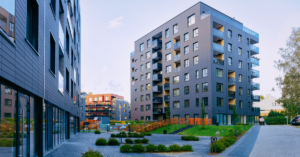It may not be the case in every market, but the nationwide consumer sentiment toward buying a home is at its lowest level in more than a decade. This has implications for owners of multifamily housing properties. And it’s a trend that commercial mortgage originators should follow closely.
Recent surveys show that fewer consumers believe now is a good time to buy a house. Fannie Mae’s Home Purchase Sentiment Index, which tracks the public’s attitude toward homebuying, decreased for a sixth consecutive month this past July to a reading of 62.8. The August index was down 13 points on a year-over-year basis. It was the lowest positive sentiment level toward homebuying since 2011 and well below the all-time high set in 2019.
Commercial mortgage originators know that the dynamics of the owner-occupied housing market often impact the outlook for apartments.
The survey also found that a mere 22% of surveyed consumers in August 2022 felt that it was a good time to buy a home. Meanwhile, the share of respondents who believed that it’s a good time to sell dropped from 76% in May to 59% in August.
These results are not unexpected after the Federal Reserve raised the federal funds rate from historic lows of near zero in March 2020 to a range of 3% to 3.25% in September 2022. To combat ongoing inflation, the Fed is prepared to continue raising rates. These increases, combined with higher home prices, are creating a slower pace of purchases as properties are staying on the market longer.
Housing impact
Commercial mortgage originators know that the dynamics of the owner- occupied housing market often impact the outlook for apartments, so it’s likely that slowing home sales will continue to increase the demand for apartments. Interestingly, the locational aspect of multifamily demand has shifted dramatically, influenced directly by the COVID-19 pandemic.
With so many people now able to work remotely, the movement of renters out of expensive coastal markets has been occurring more frequently, with many of these people in search of more space and lower costs. A variety of cities, including Atlanta, Austin, Miami, Phoenix and San Diego (as well many other Sun Belt markets), have been widely reported as common destinations for people leaving more expensive and populous areas.
A recent examination of financial details for Freddie Mac multifamily loans by commercial real estate data company Trepp reflects the trend of relocating to the Sun Belt. Among states with more than $500 million in commercial mortgage-backed securities investments in 2021, the largest annualized net operating income (NOI) growth occurred in Arizona (11.1%), Utah (10.5%), South Carolina (9.8%) and New Mexico (9.4%).
The national average NOI increase for 2021 was 3.5%. But much of this growth was centered in the Mountain region (8.5%), the South Atlantic region (5.9%), and the Southeast Central region (5.7%).
Rising costs
Reduced homebuying activity, as well as large groups of renters moving from certain markets to others, have contributed to historically high rent-price growth. Yet they aren’t the only notable factors.
Apartment owners today are reporting inflation and rising operating costs across numerous expense categories — including gas, labor, building supplies, insurance and utilities. That said, however, some multifamily developers who are leading new-construction projects (and some owners who are maintaining and renovating existing communities) are indicating that building-material costs are starting to level off.
AAA data shows that gas prices have fallen considerably in recent months. Owners and developers also have likely learned to better plan for higher-priced materials. Whatever the case, the cost of construction materials isn’t stinging quite as much, and the happy result is more projects finishing on budget.
Apartment owners today are finding more flexibility in requesting additional funds from debt and equity providers to compensate for rising costs. This is primarily because demand remains high for units across the multifamily sector. Lenders know that both elevated rent prices and lower vacancy rates will be common for the foreseeable future, thereby lowering their risk.
Slowing demand
While apartment rents are still increasing in some markets, however, rising interest rates have caused capitalization rates to increase. Some investors in the process of purchasing apartment communities have been forced to pare back their acquisition activities.
Buyers also may have to come back to the negotiating table with sellers since, factoring in higher interest rates, they can no longer get the same financing terms. The bottom line is that buyers today simply can’t pay as much as they could just a few months earlier.
The good news is that financing is still available. Some of the more aggressive lenders have clearly slowed or stalled their funding activities in response to market volatility. But more conservative lenders that are better positioned to hedge risk remain active debt options for borrowers. The Federal Housing Administration, Fannie Mae and Freddie Mac are prime examples.
Notably, however, Fannie and Freddie have forecast a contraction in 2022 originations. Citing heightened market uncertainty and a volatile Treasury rate environment, Freddie Mac’s midyear outlook projected a full-year origination volume of $440 billion to $450 billion, down 8% to 10% from 2021. Similarly, Fannie Mae downwardly revised its 2022 multifamily originations expectations, from $475 billion to $425 billion.
ESG momentum
Another aspect of the multifamily investment equation that originators should be aware of is the rise of interest in environmental, social and governance (ESG) property investment standards — and their potential impact on prices. ESG strategies are used by socially conscious investors to determine how well a company safeguards the environment; how well it manages relationships with employees, suppliers, customers and the community; and how well company leadership handles executive pay, internal issues and shareholder rights.
The government-sponsored enterprises, Fannie and Freddie, are becoming more pronounced proponents of the ESG investment strategy, a movement in which the U.S. still lags behind European nations. In a recent study by real estate services company Cushman & Wakefield, sustainability was identified as the primary investor focus across ESG’s three categories. The same study found that multifamily assets certified by the Leadership in Energy and Environmental Design (LEED) program garner rents that are 3.1% higher. Cushman & Wakefield pointed out that the agencies have established significant incentive programs for apartment assets that satisfy green-building certifications and efficiency metrics. These incentives include lower interest rates and additional loan proceeds.
The sustainable-finance incentive programs offered by Fannie Mae and Freddie Mac each serve apartment owners who facilitate renovations that enhance efficiency via energy and water conservation. If participating owners are financing properties that are also categorized as affordable, these incentives are even more appealing. Owners that incorporate sustainability enhancements into their repositioning plans will not only be able to access lower financing rates through the agencies but also can increase their rents to further boost their return on investment.
The multifamily sector’s push toward greater sustainability, as well as an overall interest in ESG strategies, will continue to climb. Many consumers who rent want to lower their carbon footprint and are willing to pay a bit more to live in eco-friendly communities. Likewise, investors large and small are looking to increase allocations to ESG-focused projects, including multifamily properties. Amid the market uncertainty of the day, the sustainability movement is a positive one.
● ● ●
Multifamily housing remains in high demand, due in part to the higher prices and rising interest rates associated with owning a single-family home. While apartments are facing their own headwinds of higher construction costs and interest rates, originators should be aware of special government-backed environmental programs that can make multifamily investments even more attractive to their clients. ●
Author
-

Ann Atkinson is a managing director specializing in small- balance loans and market real estate production for Sabal Capital Partners LLC, a wholly owned subsidiary of Regions Bank. Atkinson oversees production across the nationwide lender’s Freddie Mac and Fannie Mae loan programs.





